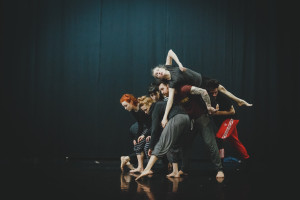I love watching people; their quirks and idiosyncrasies, and the way they function in different social scenarios. So I wanted to make a piece which is largely about social dynamics- exploring the relationships between people and how they behave when they are in a group, a couple or on their own. What makes people form a group or a particular connection with someone? What ostracises people from one another and how does this affect their behaviour?
The piece also has a lot to do with the theme of manipulation and how people can manipulate others both negatively, i.e for their own personal gain, but sometimes also positively. There are many different elements to the work, but it was this particular theme that gave me a lot of ideas for physical exploration with the dancers and it has proved incredibly interesting. I was also hugely inspired by the variety and expressions of the characters and communities you see in 17th and 18th century oil paintings. I think that, through the nature of the piece, the set and the costume design you can see that I like to create pieces which have no place in a specific era or community- they simply reference human experience, past, present and future and this allows the audience a real freedom of interpretation.
In the run up to Christmas, I set the dancers some tasks based on the 17th and 18th century oil paintings in order to allow them to begin creating a character and exploring what the physicality of that character might be. The dancers did amazingly with this task, creating such a palette of colourful characters and generating a wealth of physicalities for me to develop further.
I then started with a movement phrase of my own which I taught to the dancers. This is always helpful, to both me and the dancers, when we haven’t worked with each other before since it helps them get used to my way of moving and it also enables me to see how each dancers interprets my movement differently. Essentially this phrase became our ‘language’ for the piece and from that, we created many different sentences and phrases, identifying different ways in which we could adapt and evolve that initial phrase of movement. I used a lot of the dancers own material too, just adding my own ‘punctuation’ in their sentences.
The process is really a combination of me guiding the dancers with information, images and sometimes very specific physical details on very specific counts, but also allowing space for their own creative ideas and impulses.
The magic for me in this process has been the ‘mistakes’- when I am working with the dancers and we are in a flow and something happens which the dancer thinks is wrong because it is not exactly what I had asked for, but then I realise that what just happened is a thousand times better than what I had imagined! And then we develop the ‘mistake’….I love these moments!
For Folk I wanted to create a surreal-yet-familiar community for the characters in the piece to exist in. A world which is not immediately identifiable or recognisable, yet which we can all relate to on some level. The music is quite eclectic. It is a mix of Folk, Balkan, Baroque and classical. A couple of tracks with definitely be pieces the audiences have heard before! It’s a piece which has some quite intense, dark moments but also a dash of dark British humour!
Caroline Finn’s Folk will have its world premiere as part of National Dance Company Wales’ Spring Tour, which will be touring to:
Taliesin Arts Centre, Swansea – 4 February
Venue Cymru, Llandudno – 12 February
Sherman Theatre, Cardiff – 18 & 19 February
Lawrence Batley Theatre – 10 March
The Place, London – 12 April
Aberystwyth Arts Centre – 21 April
Torch Theatre, Milford Haven – 27 April
Theatr Clwyd, Mold – 13 & 14 May.
Ndcwales.co.uk
Rehearsal pictures: Rhys Cozens




